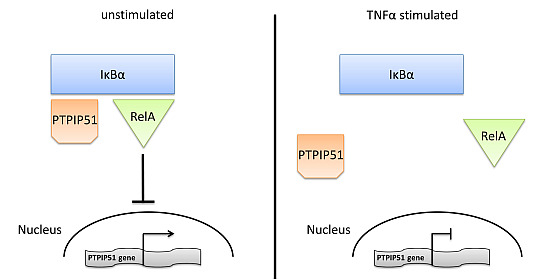PTPIP51—A New RelA-tionship with the NFκB Signaling Pathway
Abstract
:1. Introduction
2. Results
2.1. The PTPIP51 and RelA mRNA Expression is Regulated by TNFα Administration
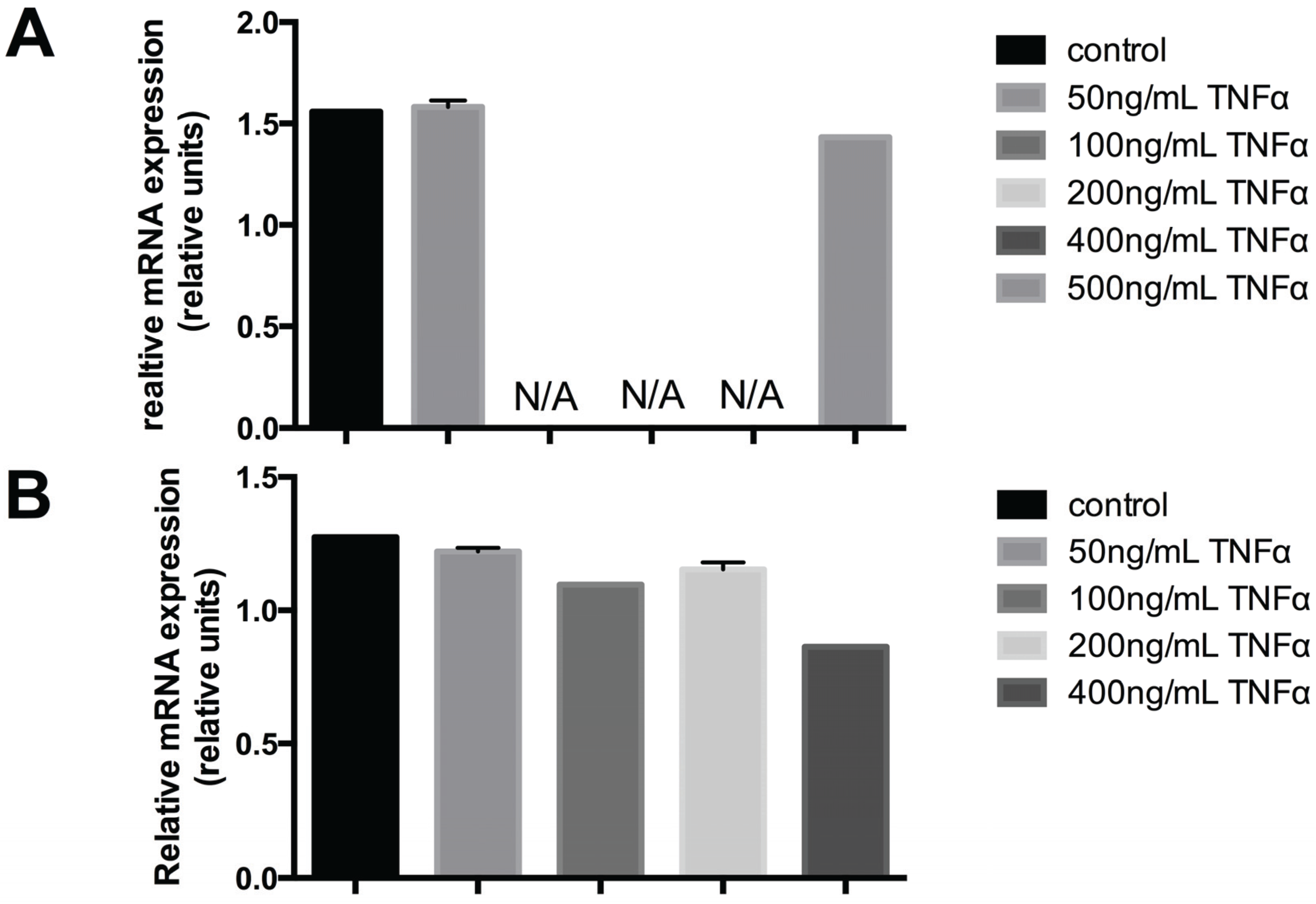
2.2. The PTPIP51 Protein Expression is also Regulated by TNFα
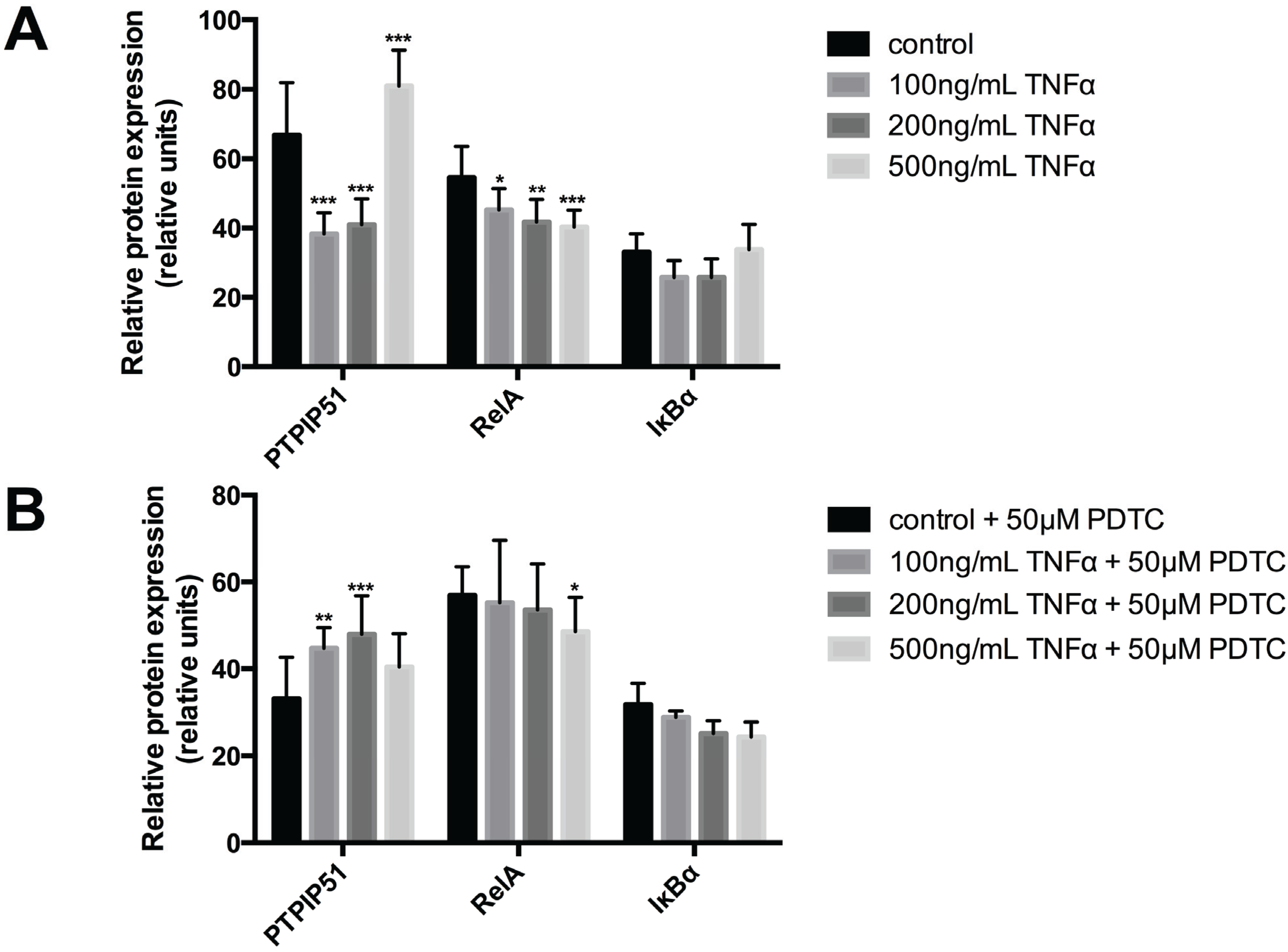
2.3. PTPIP51 is co-Localized with RelA in the HaCaT Cell Line and the co-Localization is Altered by TNFα

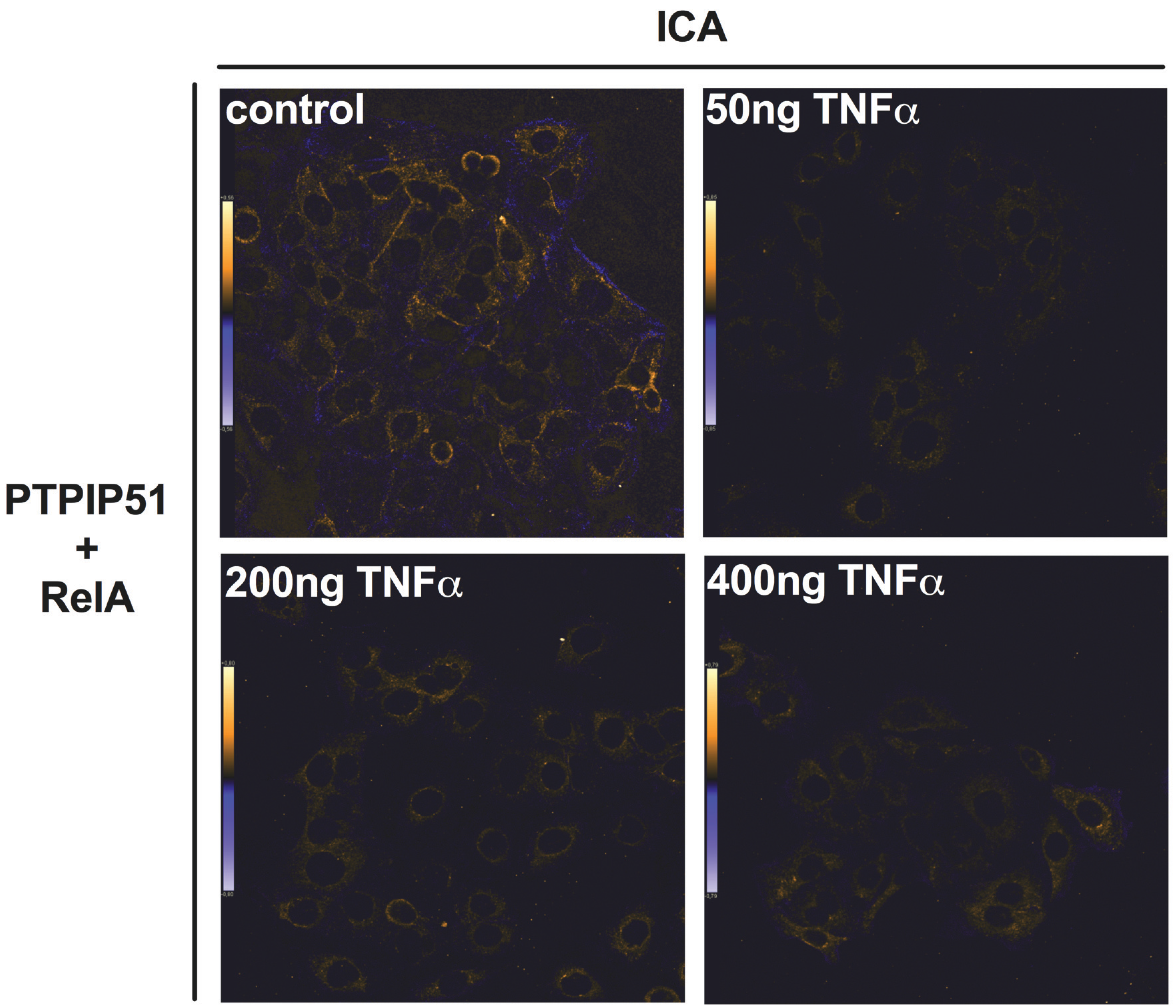
2.4. PTPIP51 Interacts with RelA in HaCaT Cells

2.5. PTPIP51 Interacts with IκBα in HaCaT Cells
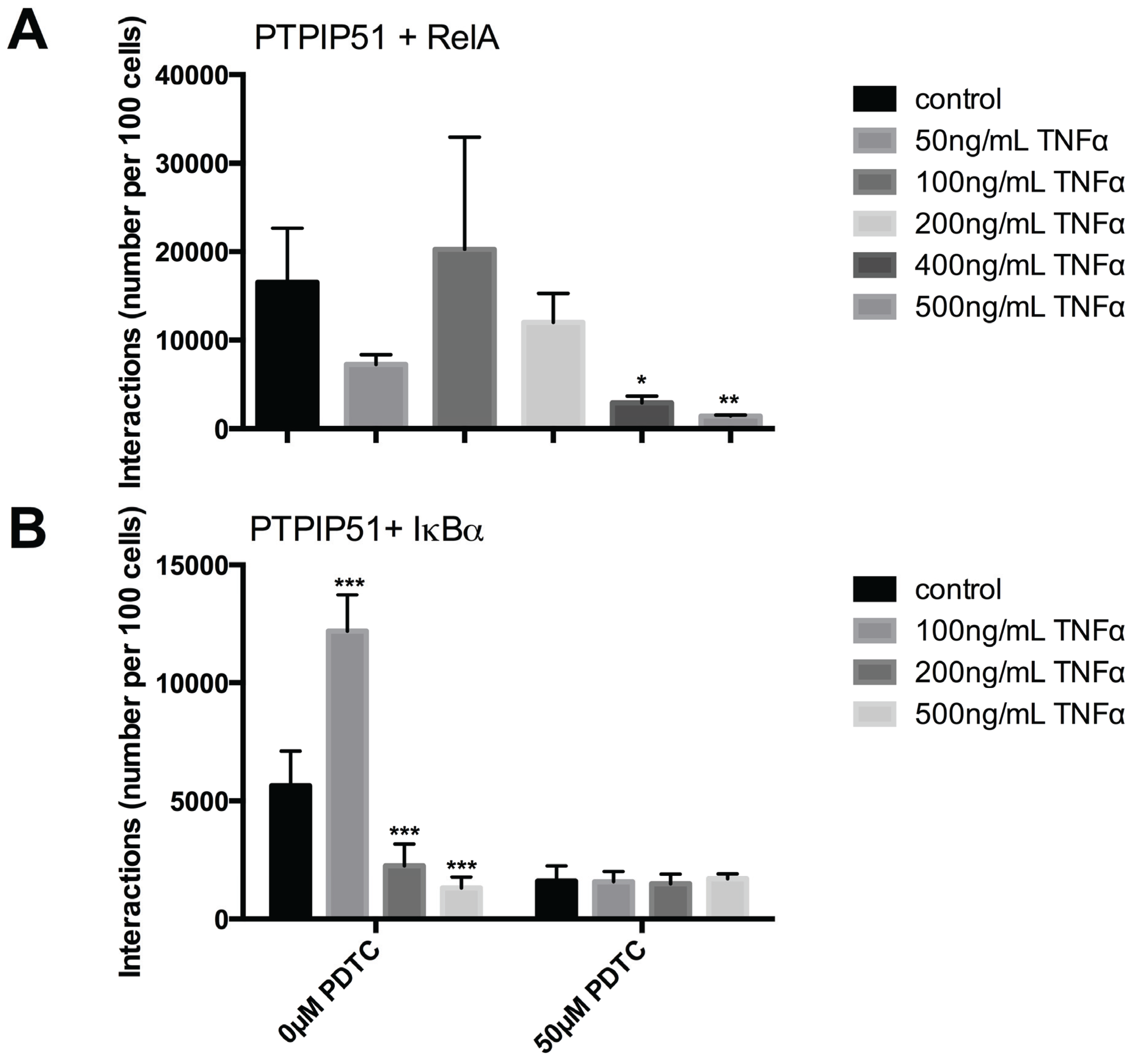

2.6. PTPIP51 Interacts with 14-3-3, Raf-1, MEK1 in HaCaT Cells
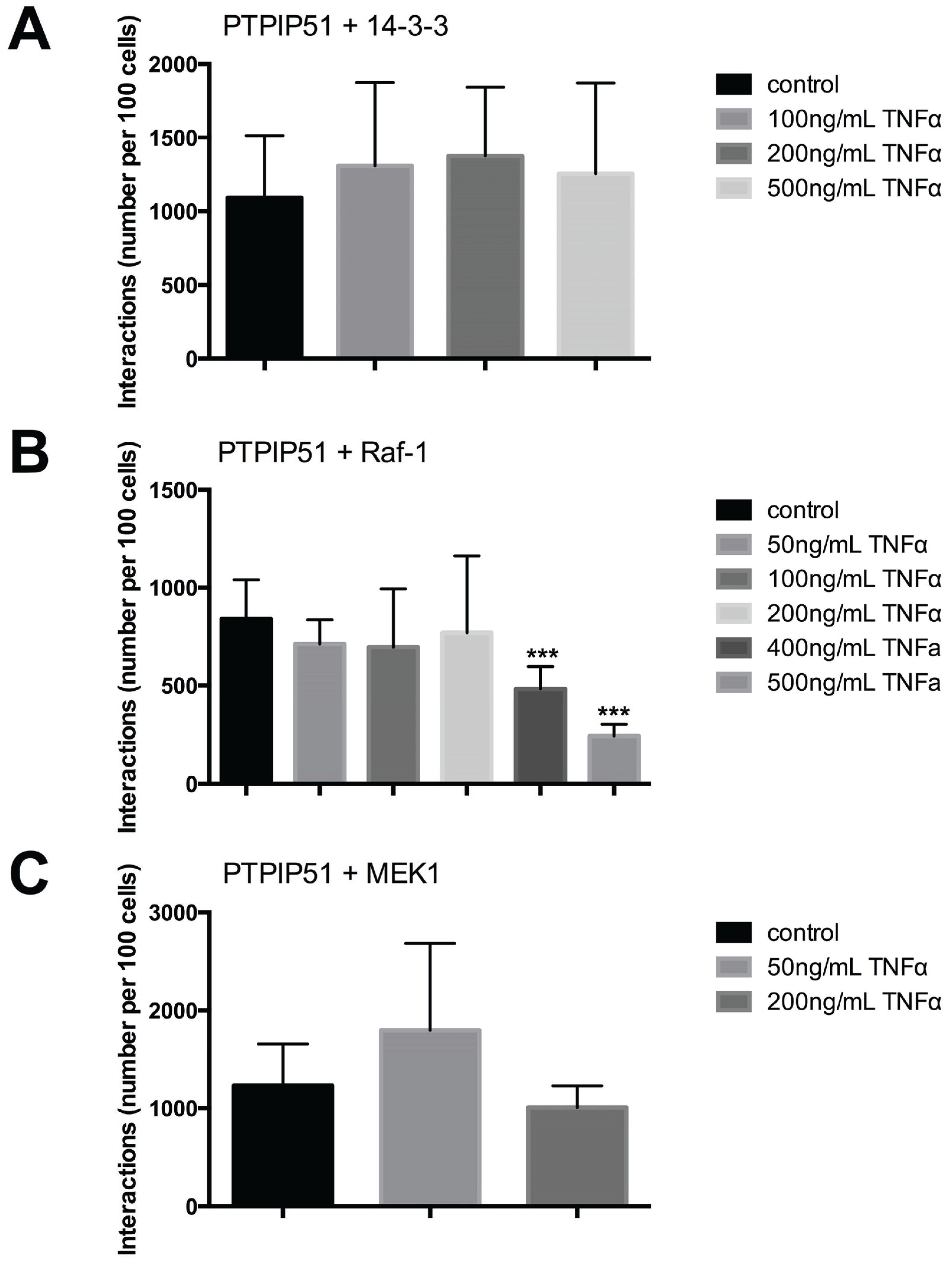
2.7. PTPIP51 Interacts with PKA, PTP1B in HaCaT Cells
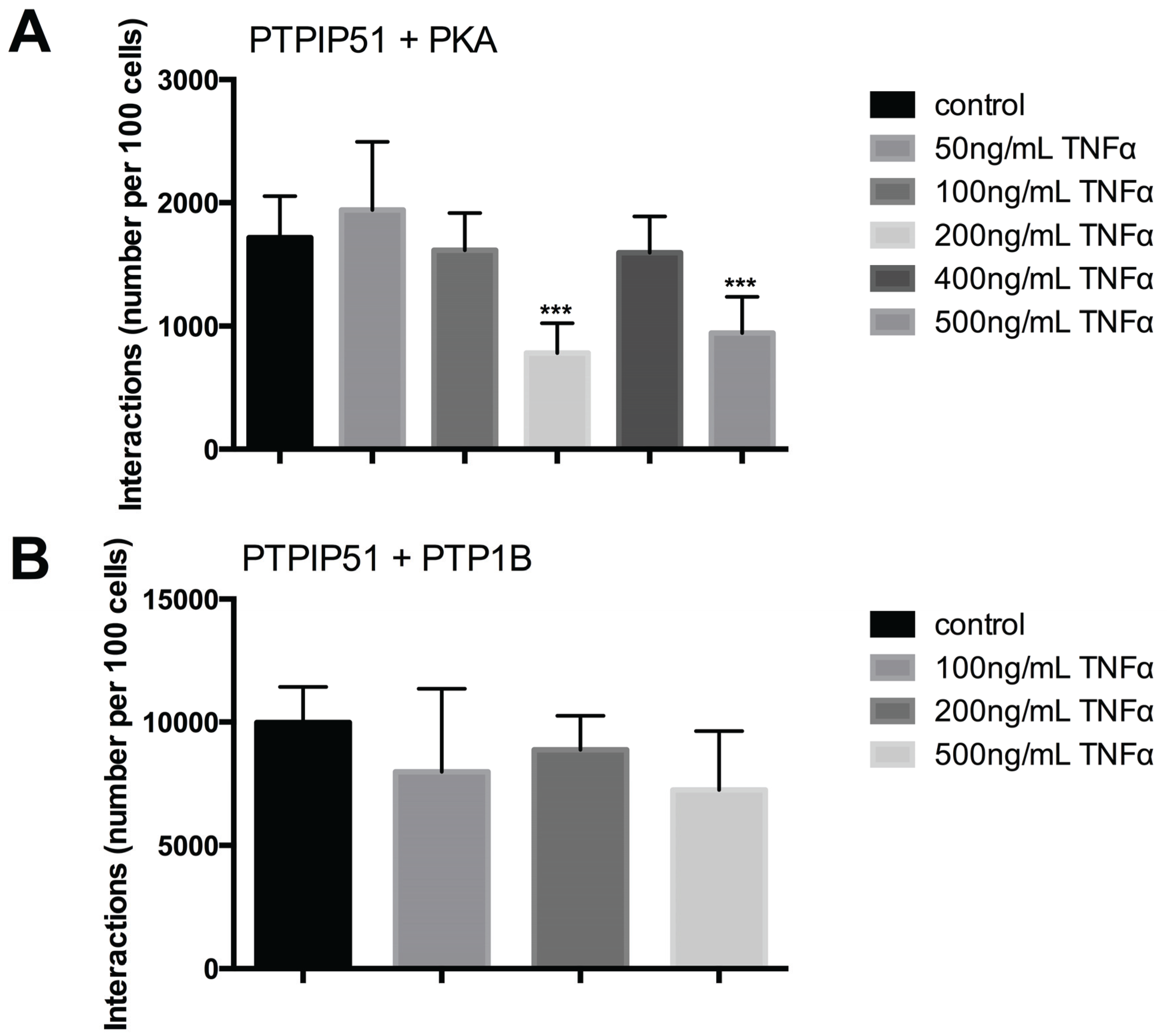
3. Discussion
4. Experimental Section
4.1. Cell Culture
| Antibody | Immunogen | Antibody Source | Clone | Dilution | Manufacturer |
|---|---|---|---|---|---|
| PTPIP51 (P51ab) | Human recombinant PTPIP51 protein encoding amino acids (aa) 131–470 | Rabbit polyclonal | 1:500 | Prof. H. W. Hofer, Biochemical Department, University Konstanz, Germany | |
| RelA | Peptide corresponding to human p65 coupled to BSA | Mouse monoclonal | 12H11 | 1:100 | Merck Millipore, Schwalbach, Germany Cat.# MAB3026 |
| PTP1B | Recombinant protein corresponding to aa 1–321 of human PTP1B | Mouse monoclonal | 107AT531 | 1:200 | Abnova, Taipei, Taiwan Cat.# MAB1152 |
| Raf-1 | Mapping the C-terminus of Raf-1 | Mouse monoclonal | E-10 | 1:100 | Santa Cruz Biotechnology, Dallas, TX, USA Cat.# sc-7267 |
| PKA | Recombinant fragment corresponding to aa 1–121 of human PKA | Mouse monoclonal | N/A | 1:100 | Abcam, Cambridge, UK Cat.#ab58187 |
| IκBα | Recombinant Human IκB alpha/NFKBIA protein 02 | Mouse monoclonal | MM02 | 1:100 | Sino Biological Inc., North Wales, PA, USA Cat.# 12045-H07E |
| 14-3-3beta | Specfic for an epitope mapping between aa 220–244 at the C-terminus of 14-3-3β of human origin | Mouse monoclonal | A-6 | 1:100 | Santa Cruz Biotechnology, Dallas, TX, USA Cat.#sc-25276 |
| MEK1 | Purified MEK from human T cells and recombinant MEK1 | Mouse monoclonal | 3D9 | 1:100 | Life Technologies, Carlsbad, CA, USA Cat.# 13-3500 |
4.2. TNFα Treatment
4.3. Quantitative Real Time PCR
4.4. PTPIP51 Antibody (aa 131–470)
4.5. Immunohistochemistry
4.6. Epifluorescence Microscopy
4.7. Confocal Laser Scanning Microscopy
4.8. Semiquantification of Immunofluorescence Intensities
4.9. Duolink Proximity Ligation Assay (DPLA)
4.10. Statistical Analysis
5. Conclusions
Author Contributions
Conflicts of Interest
References
- Brobeil, A.; Bobrich, M.; Tag, C.; Wimmer, M. PTPIP51 in protein interactions: Regulation and in situ interacting partners. Cell Biochem. Biophys. 2012, 63, 211–222. [Google Scholar] [CrossRef] [PubMed]
- Brobeil, A.; Koch, P.; Eiber, M.; Tag, C.; Wimmer, M. The known interactome of PTPIP51 in HaCaT cells—Inhibition of kinases and receptors. Int. J. Biochem. Cell Biol. 2014, 46, 19–31. [Google Scholar] [CrossRef] [PubMed]
- Yu, C.; Han, W.; Shi, T.; Lv, B.; He, Q.; Zhang, Y.; Li, T.; Zhang, Y.; Song, Q.; Wang, L.; et al. PTPIP51, a novel 14-3-3 binding protein, regulates cell morphology and motility via Raf-ERK pathway. Cell. Signal. 2008, 20, 2208–2220. [Google Scholar] [CrossRef] [PubMed]
- Brobeil, A.; Graf, M.; Eiber, M.; Wimmer, M. Interaction of PTPIP51 with Tubulin, CGI-99 and Nuf2 during Cell Cycle Progression. Biomolecules 2012, 2, 122–142. [Google Scholar] [CrossRef] [PubMed]
- De Vos, K.J.; Morotz, G.M.; Stoica, R.; Tudor, E.L.; Lau, K.F.; Ackerley, S.; Warley, A.; Shaw, C.E.; Miller, C.C.J. VAPB interacts with the mitochondrial protein PTPIP51 to regulate calcium homeostasis. Hum. Mol. Genet. 2012, 21, 1299–1311. [Google Scholar] [CrossRef] [PubMed]
- Lv, B.F.; Yu, C.F.; Chen, Y.Y.; Lu, Y.; Guo, J.H.; Song, Q.S.; Ma, D.L.; Shi, T.P.; Wang, L. Protein tyrosine phosphatase interacting protein 51 (PTPIP51) is a novel mitochondria protein with an N-terminal mitochondrial targeting sequence and induces apoptosis. Apoptosis 2006, 11, 1489–1501. [Google Scholar] [CrossRef] [PubMed]
- Sheng, W.S.; Hu, S.; Ni, H.T.; Rowen, T.N.; Lokensgard, J.R.; Peterson, P.K. TNF-alpha-induced chemokine production and apoptosis in human neural precursor cells. J. Leukoc. Biol. 2005, 78, 1233–1241. [Google Scholar] [CrossRef] [PubMed]
- Polunovsky, V.A.; Wendt, C.H.; Ingbar, D.H.; Peterson, M.S.; Bitterman, P.B. Induction of endothelial cell apoptosis by TNF alpha: Modulation by inhibitors of protein synthesis. Exp. Cell Res. 1994, 214, 584–594. [Google Scholar] [CrossRef] [PubMed]
- Miao, Y.; Bi, X.-Y.; Zhao, M.; Jiang, H.-K.; Liu, J.-J.; Li, D.-L.; Yu, X.-J.; Yang, Y.-H.; Huang, N.; Zang, W.-J. Acetylcholine inhibits tumor necrosis factor α activated endoplasmic reticulum apoptotic pathway via EGFR-PI3K signaling in cardiomyocytes. J. Cell. Physiol. 2015, 230, 767–774. [Google Scholar] [CrossRef] [PubMed]
- Petersen, S.L.; Wang, L.; Yalcin-Chin, A.; Li, L.; Peyton, M.; Minna, J.; Harran, P.; Wang, X. Autocrine TNFalpha signaling renders human cancer cells susceptible to Smac-mimetic-induced apoptosis. Cancer Cell 2007, 12, 445–456. [Google Scholar] [CrossRef]
- Zhang, B.; Wu, T.; Wang, Z.; Zhang, Y.; Wang, J.; Yang, B.; Zhao, Y.; Rao, Z.; Gao, J. p38MAPK activation mediates tumor necrosis factor-α-induced apoptosis in glioma cells. Mol. Med. Rep. 2015, 11, 3101–3107. [Google Scholar] [PubMed]
- Petri, M.K.; Koch, P.; Stenzinger, A.; Kuchelmeister, K.; Nestler, U.; Paradowska, A.; Steger, K.; Brobeil, A.; Viard, M.; Wimmer, M. PTPIP51, a positive modulator of the MAPK/Erk pathway, is upregulated in glioblastoma and interacts with 14-3-3β and PTP1B in situ. Histol. Histopathol. 2011, 26, 1531–1543. [Google Scholar] [PubMed]
- Sheikh, M.S.; Huang, Y. Death receptor activation complexes: It takes two to activate TNF receptor 1. Cell Cycle 2003, 2, 550–552. [Google Scholar] [PubMed]
- Transcription Factor ChiP-seq (RelA). FAM82A2. Available online: http://genome-euro.ucsc.edu/cgi-bin/hgc?hgsid=202527326_3b5AUkh9a5YAqi4iz4yfrOgZAsIv&c=chr15&o=41047434&t=41047841&g=wgEncodeRegTfbsClusteredV3&i=RELA (accessed on 15 February 2015).
- Oeckinghaus, A.; Ghosh, S. The NF-kappaB family of transcription factors and its regulation. Cold Spring Harb. Perspect. Biol. 2009. [Google Scholar] [CrossRef]
- Sorriento, D.; Illario, M.; Finelli, R.; Iaccarino, G. To NFκB or not to NFκB: The dilemma on how to inhibit a cancer cell fate regulator. Transl. Med. UniSa 2012, 4, 73–85. [Google Scholar] [PubMed]
- Meng, Q.; Zhi, T.; Chao, Y.; Nie, E.; Xu, X.; Shi, Q.; Hua, L.; Wang, L.; Zhan, W.; Wang, Y.; et al. Bex2 controls proliferation of human glioblastoma cells through NF-κB signaling pathway. J. Mol. Neurosci. 2014, 53, 262–270. [Google Scholar] [CrossRef] [PubMed]
- Hacibekiroglu, I.; Kodaz, H.; Erdogan, B.; Turkmen, E.; Ozcelik, M.; Esenkaya, A.; Saygi, H.M.; Uzunoglu, S.; Cicin, I. Single-agent bevacizumab is an effective treatment in recurrent glioblastoma. Med. Oncol. 2015. [Google Scholar] [CrossRef]
- Stenzinger, A.; Schreiner, D.; Pfeiffer, T.; Tag, C.; Hofer, H.-W.; Wimmer, M. Epidermal growth factor-, transforming growth factor-β-, retinoic acid- and 1,25-dihydroxyvitamin D3-regulated expression of the novel protein PTPIP51 in keratinocytes. Cells Tissues Organs 2006, 184, 76–87. [Google Scholar] [CrossRef] [PubMed]
- Saccani, S.; Marazzi, I.; Beg, A.A.; Natoli, G. Degradation of promoter-bound p65/RelA is essential for the prompt termination of the nuclear factor κB response. J. Exp. Med. 2004, 200, 107–113. [Google Scholar] [CrossRef] [PubMed]
- Kaltschmidt, B.; Kaltschmidt, C.; Hofmann, T.G.; Hehner, S.P.; Dröge, W.; Schmitz, M.L. The pro- or anti-apoptotic function of NF-κB is determined by the nature of the apoptotic stimulus. Eur. J. Biochem. 2000, 267, 3828–3835. [Google Scholar] [CrossRef] [PubMed]
- Campbell, K.J.; Rocha, S.; Perkins, N.D. Active repression of antiapoptotic gene expression by RelA(p65) NF-κB. Mol. Cell 2004, 13, 853–865. [Google Scholar] [CrossRef] [PubMed]
- Vasudevan, K.M.; Gurumurthy, S.; Rangnekar, V.M. Suppression of PTEN expression by NF-κB prevents apoptosis. Mol. Cell. Biol. 2004, 24, 1007–1021. [Google Scholar] [CrossRef] [PubMed]
- Karin, M. How NF-κB is activated: The role of the IκB kinase (IKK) complex. Oncogene 1999, 18, 6867–6874. [Google Scholar] [CrossRef] [PubMed]
- Stenzinger, A.; Schreiner, D.; Koch, P.; Hofer, H.-W.; Wimmer, M. Chapter 6: Cell and Molecular Biology of the Novel Protein Tyrosine-Phosphatase-Interacting Protein 51. In International Review of Cell and Molecular Biology; Jeon, K., Ed.; Elsevier: New York, NY, USA, 2009; Volume 275, pp. 183–246. [Google Scholar]
- Madonna, G.; Ullman, C.D.; Gentilcore, G.; Palmieri, G.; Ascierto, P.A. NF-κB as potential target in the treatment of melanoma. J. Transl. Med. 2012. [Google Scholar] [CrossRef]
- Kefaloyianni, E.; Gaitanaki, C.; Beis, I. ERK1/2 and p38-MAPK signalling pathways, through MSK1, are involved in NF-κB transactivation during oxidative stress in skeletal myoblasts. Cell. Signal. 2006, 18, 2238–2251. [Google Scholar] [CrossRef] [PubMed]
- Ahmed, K.M.; Dong, S.; Fan, M.; Li, J.J. Nuclear factor-κB p65 inhibits mitogen-activated protein kinase signaling pathway in radioresistant breast cancer cells. Mol. Cancer Res. 2006, 4, 945–955. [Google Scholar] [CrossRef] [PubMed]
- Izban, K.F.; Ergin, M.; Huang, Q.; Qin, J.Z.; Martinez, R.L.; Schnitzer, B.; Ni, H.; Nickoloff, B.J.; Alkan, S. Characterization of NF-κB expression in Hodgkin’s disease: Inhibition of constitutively expressed NF-κB results in spontaneous caspase-independent apoptosis in Hodgkin and Reed-Sternberg cells. Mod. Pathol. 2001, 14, 297–310. [Google Scholar] [CrossRef] [PubMed]
- Diehl, V.; Franklin, J.; Pfreundschuh, M.; Lathan, B.; Paulus, U.; Hasenclever, D.; Tesch, H.; Herrmann, R.; Dörken, B.; Müller-Hermelink, H.K.; et al. Standard and increased-dose BEACOPP chemotherapy compared with COPP-ABVD for advanced Hodgkin’s disease. N. Engl. J. Med. 2003, 348, 2386–2395. [Google Scholar] [CrossRef] [PubMed]
- Rodriguez, M.A.; Fuller, L.M.; Zimmerman, S.O.; Allen, P.K.; Brown, B.W.; Munsell, M.F.; Hagemeister, F.B.; McLaughlin, P.; Velasquez, W.S.; Swan, F., Jr.; et al. Hodgkin’s disease: Study of treatment intensities and incidences of second malignancies. Ann. Oncol. 1993, 4, 125–131. [Google Scholar] [PubMed]
- Brobeil, A.; Bobrich, M.; Wimmer, M. Protein tyrosine phosphatase interacting protein 51—A jack-of-all-trades protein. Cell Tissue Res. 2011, 344, 189–205. [Google Scholar] [CrossRef] [PubMed]
- Koch, P.; Viard, M.; Stenzinger, A.; Brobeil, A.; Tag, C.; Steger, K.; Wimmer, M. Expression profile of PTPIP51 in mouse brain. J. Comp. Neurol. 2009, 517, 892–905. [Google Scholar] [CrossRef] [PubMed]
- Brobeil, A.; Graf, M.; Oeschger, S.; Steger, K.; Wimmer, M. PTPIP51—A myeloid lineage specific protein interacts with PTP1B in neutrophil granulocytes. Blood Cells Mol. Dis. 2010, 45, 159–168. [Google Scholar] [CrossRef] [PubMed]
- Gajadhar, A.; Guha, A. A proximity ligation assay using transiently transfected, epitope-tagged proteins: Application for in situ detection of dimerized receptor tyrosine kinases. Biotechniques 2010, 48, 145–152. [Google Scholar] [CrossRef] [PubMed]
© 2015 by the authors; licensee MDPI, Basel, Switzerland. This article is an open access article distributed under the terms and conditions of the Creative Commons Attribution license (http://creativecommons.org/licenses/by/4.0/).
Share and Cite
Brobeil, A.; Kämmerer, F.; Tag, C.; Steger, K.; Gattenlöhner, S.; Wimmer, M. PTPIP51—A New RelA-tionship with the NFκB Signaling Pathway. Biomolecules 2015, 5, 485-504. https://doi.org/10.3390/biom5020485
Brobeil A, Kämmerer F, Tag C, Steger K, Gattenlöhner S, Wimmer M. PTPIP51—A New RelA-tionship with the NFκB Signaling Pathway. Biomolecules. 2015; 5(2):485-504. https://doi.org/10.3390/biom5020485
Chicago/Turabian StyleBrobeil, Alexander, Fabian Kämmerer, Claudia Tag, Klaus Steger, Stefan Gattenlöhner, and Monika Wimmer. 2015. "PTPIP51—A New RelA-tionship with the NFκB Signaling Pathway" Biomolecules 5, no. 2: 485-504. https://doi.org/10.3390/biom5020485




